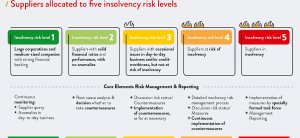Spotting potential supplier insolvency at an early stage can save companies a large amount of money and stress. Companies can manage the risk if they start early enough and take proactive measures, as demonstrated by an example from a mechanical engineering company.
Suppliers slipping into insolvency have long been only a theoretical risk for many companies. Transparency about these suppliers and early warning systems that ring the alarm when the first problems arise were – and still are – far too rare. The coronavirus pandemic has taught many companies that this risk is very real – and that it may cause huge revenue losses and competitive disadvantages in the months ahead. Over the last year, concerns about future bottlenecks, production outages and the resulting sales losses have also prompted our client – a major German mechanical engineering company – to initiate a risk prevention project.
Typically for many medium-sized companies, risk management has long been just one of many issues. Risk assessment and supplier monitoring in many companies is still not given enough attention to, often not on the agenda until a supplier is already facing difficulties. As a result, any countermeasures taken are too late and too reactive. This was also the case with our client, who wanted to rework its supplier risk analysis procedures from the ground. Previously, our client relied almost entirely on information from a credit rating agency. As credit reports are majorily triggered by payment delays or defaults, taking this approach meant that the company would lose valuable time in responding to the situation. We worked on a project with our client to set up a new warning system that would incorporate comprehensive qualitative aspects into their decision-making. We also implemented standardized processes that significantly increased transparency.
Where our client had previously only been able to assess the risk of supplier insolvency at best for 10% of all cases, the new warning system boosted this figure to over 90%. This means our client is now able to identify potential insolvencies, take action at an early stage, develop relationships with alternative suppliers and, in the worst-case, use acquisitions to maintain production. The result is a crucial competitive advantage.
Implementing Comprehensive Supplier Monitoring Processes
The name of the game in risk management is being able to react at an early stage. To make this happen, our client had to broaden the perspective and assess risks from various angles. In order to produce a comprehensive assessment for each supplier, we compared data from credit reports with the suppliers’ own information and the impressions of in-house colleagues. We also included external data from ongoing press clippings in our evaluation. Our risk assessment process consists of four steps:
Step 1: Collecting and Inputting Data
Specifically, this includes a supplier survey asking them about their current situation, an internal supplier-assessment by the buyer, and information from commercial credit insurance companies – who are much quicker than credit agencies to evaluate solvency. We also recommend monitoring the press to identify important news around suppliers immediately, to quickly react if necessary.
It is also essential to evaluate which impact each supplier has for the own production. If a supplier offers a unique product, or particularly holds a patent on this, then the evaluation should resonate this accordingly. Once all the data has been collected, it is helpful to create a master database, for gaining an overview and creating a profound base for the assessments.
We used the collected information to determine different levels of insolvency risk, making it easier to assess the situation for each supplier, especially for longstanding partners and in extraordinary situations. Using a mathematical If-Then model would have ignored qualitative criteria and assessments.
Step 2: Recognizing the Risk of Insolvency
The next step is to use the data to identify where ad hoc measures may potentially be required. It made sense for our client to classify its suppliers into five different categories, based on the risk of insolvency. Continuing to monitor suppliers in the first (best) category is useful, but specific measures are not required.
If suppliers are in categories two and three, then we recommend an initial comprehensive in-house assessment by all departments that have contact with the supplier to identify any irregularities in day-to-day operations (e.g. switching to cheaper materials, or asking for shorter payment terms). The next step is actively engaging with these suppliers – at executive level, if possible – and having a transparent conversation about the current observations. During the conversation, each supplier should answer specific questions about their financial and order intake situation – we compiled a catalog of questions for our client to use for guidance here.

Suppliers in the fourth category have severe insolvency risk and particularly need special attention, by running a comprehensive plan of measures. This includes having open discussions with the supplier’s management about a joint future, as well as offering help. The support can be quite flexible, as offering upstream suppliers for a payment guarantee, offering advance payments for major orders or any other measures to help stabilizing the situation. This approach also includes measures that can improve or support a supplier’s lines of credit with banks.
At the same time, we agreed with our client that the sourcing team should investigate alternatives and, if necessary, expedite approval processes. The team will give the board weekly progress reports in order to maximize focus on the subject.
If a supplier becomes insolvent (category 5), the defined procedure for our client is to respond actively and proactively implementing measures to safeguard an ongoing supply. These measures include holding meetings and opening negotiations with the insolvency administrator at an early stage. In return of giving preferential treatment, a long-term award of future orders could be placed or increasing prices as a last resort. If unique components are affected and losing a supplier would have serious consequences for our client, then the management team may also consider taking extraordinary measures – including examining whether it would be worth acquiring that supplier. In our client’s case, taking this step was the best solution to secure a highly specialized component as well as the associated knowledge and – most importantly – to safeguard stable supplies to their customers.




